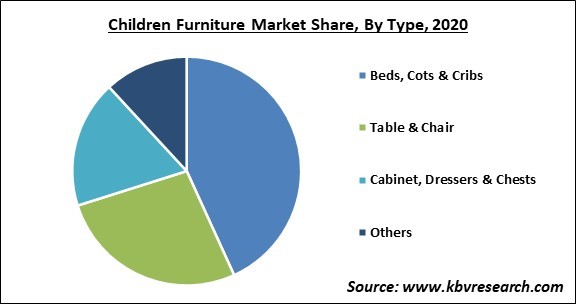The Global Children Furniture Market size is expected to reach $34 billion by 2027, rising at a market growth of 4.4% CAGR during the forecast period.
Children's furniture is designed specifically for young children and babies. They are a fraction of the size of ordinary furniture. These pieces of furniture are typically constructed of wood, although they can also be made of other materials viz. polymer or metal. They might be stationary or moveable. They're made to satisfy the ergonomic needs of children at various stages of development. Children's furniture has features such as easy cleaning, low upkeep, and blunt edges.
One of the key catalysts for the growth of the market includes increase in population density in metro areas and rising disposable income of the consumers around the world. In addition, many people are primarily migrating from rural areas to urban areas in search of work, and they are bringing their families with them.
Such a significant influx of people opens up prospects for real estate, hotels and restaurants, hospitals, and clinics, all of which require various sorts of furniture, including children furniture. As the world's population becomes more urbanized, there is a greater demand for children furniture.
Because of the increased awareness among parents about the convenience given by these goods, the usage of baby furniture has become fashionable. The furniture keeps babies from rolling off the bed, allowing them to sleep safely and comfortably. Due to the willingness to spend more on baby products, dual-income earning households around the world are contributing to the increased consumption of the product.
In numerous growing countries, migration to metropolitan areas and metro cities is leading to the construction of small apartments, which is a major factor driving demand for compact and easy-to-move furniture. The growing population and increasing adoption of urbanization in developing nations are expected to provide profitable possibilities for manufacturers of children's furniture.

The sudden outburst of the COVID-19 pandemic demolished the economy of the world. From startups and small enterprises to large enterprises, all the entities were highly affected by the novel coronavirus. In addition, due to the lockdown enforced by the government of all countries across the world, all the businesses and occupations were devastated. The declining production was attributed to the closure of all the manufacturing facilities as well as the lumberjack business and sawmills.
Moreover, because of online schooling and classes, the demand for children furniture from schools and nurseries declined drastically. Therefore, the COVID-19 pandemic majorly hampered the children furniture market. However, parents that were determined to create a school-like environment for their children still preferred different types of children furniture during the pandemic period.
Consumer preferences for designer furniture are shifting in the children furniture sector. As people become more aware of the negative effects of plastic on the environment, market players are seizing new chances in fancy and designer children furniture. Similarly, furniture constructed from recycled plastic and abandoned plastic toys are being developed.
Children furniture can support the health of the children by keeping their back intact while sitting. Furniture that is designed specifically to meet the requirements of children is incredibly relaxing. Many of these products include backrests that wrap around the waist for added comfort while leaning. While, some of them have backrests with dual flaps. Some Ergonomic furniture comprises tables that can be inclined 25 degrees to enable children to sit comfortably while attending classes and doing homework without straining their eyes and back.
Children furniture products are very beneficial in terms of durability, compaction, and flexibility. However, the cost that occurs during the production and manufacturing is very high. These products are made up of materials such as wood, polymer, and metal that are very expensive when bought in raw form. For instance, wood such as cherry and walnut are extremely high in terms of cost. Similarly, the prices of other materials viz. polymer and metal are also extremely high.

Based on the Sales channel, the Children furniture market is divided into Online channels and Offline channels. In 2020, the online channels segment followed the offline channels segment by accounting for a substantial revenue share of the children furniture market. Online channels for purchasing children-specific furniture allow parents to conveniently purchase goods for their children and get them delivered to their doorstep in a short period of time.
Based on the Type, the Children furniture market is segmented into Beds, Cots & Cribs, tables & chairs, cabinets, Dressers & Chests, and Others. The Table and chair segment held a significant revenue share of the children furniture market in 2020. The growth of this segment is due to the fact that tables & chairs for children are often smaller in size, and can be installed at home. Children specialized tables and chairs require minimal investment from parents. The low cost and space-saving attributes of the products under this segment present new and lucrative opportunities for producers to gain wider consumer base.
Based on the Material, the Children furniture market is segregated into Wood, Polymer, and Metal. In 2020, the wood segment collected the maximum revenue share of the overall children furniture market. Depending on the type of furniture, consumers expect to prefer different materials. Consumers favor wood over other materials due to its numerous advantages. Both chairs and tables can support a higher load without breaking down since wood is significantly stronger in load-bearing.
Based on End-User, the Children Furniture Market is segmented into residential and commercial. In 2020, the residential segment led the children furniture market by accounting for the largest revenue share of the market. The growth of this segment is due to the closure of schools because of the coronavirus pandemic and online classes. As a result, it became important for parents to create a comfortable classroom for their children at home to help them study.
| Report Attribute | Details |
|---|---|
| Market size value in 2020 | USD 25.9 Billion |
| Market size forecast in 2027 | USD 34 Billion |
| Base Year | 2020 |
| Historical Period | 2017 to 2019 |
| Forecast Period | 2021 to 2027 |
| Revenue Growth Rate | CAGR of 4.4% from 2021 to 2027 |
| Number of Pages | 228 |
| Number of Tables | 430 |
| Report coverage | Market Trends, Revenue Estimation and Forecast, Segmentation Analysis, Regional and Country Breakdown, Companies Strategic Developments, Company Profiling |
| Segments covered | Sales Channel, Type, Material, Region |
| Country scope | US, Canada, Mexico, Germany, UK, France, Russia, Spain, Italy, China, Japan, India, South Korea, Singapore, Malaysia, Brazil, Argentina, UAE, Saudi Arabia, South Africa, Nigeria |
| Growth Drivers |
|
| Restraints |
|
Based on the Region, the Children Furniture Market is analysed across North America, Europe, APAC, and LAMEA. In 2020, North America dominated the children furniture market by obtaining the largest revenue share in the world. North America is witnessing a rising number of daycare and childcare facilities providers which is a major factor driving up demand for children's furniture. Moreover, the growth of the industry is due to an increase in on-site childcare services, which has been aided by government programs to encourage working mothers.
Free Valuable Insights: Global Children Furniture Market size to reach USD 34 Billion by 2027
The market research report covers the analysis of key stake holders of the market. Key companies profiled in the report include Sauder Woodworking Co., Herman Miller, Inc., Nilkamal Limited, Pil Italica Lifestyle Limited (Dawood Investment Private Limited), Inter IKEA Systems B.V., Tramontina Multi S. A., Cosmoplast Industrial Company L.L.C. (Harwal Ltd.), Sleep Number Corporation, Keter Group B.V. (BC Partners), and Cello Group.
By Sales Channel
By Type
By Material
By End User
By Geography
The children furniture market size is projected to reach USD 34 billion by 2027.
Increasing demand for fancy children furniture are driving the market in coming years, however, high-cost raw materials and risk of low quality of the product have limited the growth of the market.
Sauder Woodworking Co., Herman Miller, Inc., Nilkamal Limited, Pil Italica Lifestyle Limited (Dawood Investment Private Limited), Inter IKEA Systems B.V., Tramontina Multi S. A., Cosmoplast Industrial Company L.L.C. (Harwal Ltd.), Sleep Number Corporation, Keter Group B.V. (BC Partners), and Cello Group.
The Beds, Cots & Cribs market acquired maximum revenue share in the Global Children Furniture Market by Type 2020, thereby, achieving a market value of $13.6 billion by 2027.
The Polymers market shows highest growth rate of 4.2% during (2021 - 2027).
The North America market is the fastest growing region in the Global Children Furniture Market by Region 2020, and would continue to be a dominant market till 2027.
Our team of dedicated experts can provide you with attractive expansion opportunities for your business.

